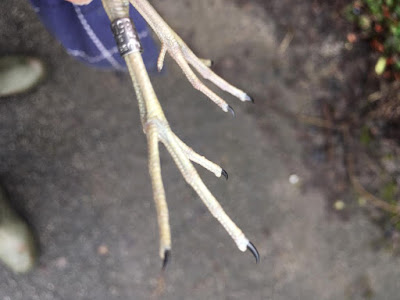I needed to make up for last night so I visited my superb Jack Snipe site to see if any were still there. It looks like there are still birds lingering and feeding up ready to migrate ( another three retraps from the site)--but there are still new birds passing through. I saw 13 Jack Snipe of which I caught 4--including one new bird.
As I've tried to point out previously, ageing this species is tricky, but we feel we are coming closer to being more confident-- but you still have to be very wary and look at a variety of clues. This is a known adult and at first sight the outer primary looks rather pointed like a juvenile. On closer inspection you can see that this bird appears to have interrupted its primary moult and you can see the outer three primaries are old, faded and pointed due to wear:-
We have recently come across a fairly new paper by some French ornithologists using the pattern on the outer tail feather to age birds, which they reckon is very accurate--but only until November. After that they reckon it is not as reliable. However, used with other clues, we are feeling quite confident. A known adult from today showed the adult appearance of this feather with a broad black section at the tip and a cream blotch on one side with a whiter one on the other:-
This contrasts with the juvenile outer tail feather shown here which has a fine black line at the tip and a continuous white outer margin to the feather--apologies for my useless focus but you can still see the effect:-
Finally, I posted a couple of pictures a while ago about the leg colour differences between juveniles and adults--the former looking green, and the latter blue. We've been really checking this out carefully and we would like to revise this. Juveniles have uniform green legs and feet, whereas adult are less uniform with the feet being a different colour to the legs. The leg colour does vary however, from green to blue but the feet of adults develop a sort of straw/pink colour. I've tried to show that in the picture but I'm not sure it's come across too well:-
They certainly don't look green anyway!




Hello everyone, Are you into trading or just wish to give it a try, please becareful on the platform you choose to invest on and the manager you choose to manage your account because that’s where failure starts from be wise. After reading so much comment i had to give trading tips a try, I have to come to the conclusion that binary options pays massively but the masses has refused to show us the right way to earn That’s why I have to give trading tips the accolades because they have been so helpful to traders . For a free masterclass strategy kindly contact (paytondyian699@gmail.com) for a free masterclass strategy. He'll give you a free tutors on how you can earn and recover your losses in trading for free..
ReplyDelete